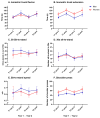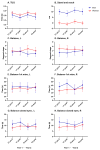Short- and Long-Term Effects on Physical Fitness in Older Adults: Results from an 8-Week Exercise Program Repeated in Two Consecutive Years
- PMID: 39846585
- PMCID: PMC11755621
- DOI: 10.3390/geriatrics10010015
Short- and Long-Term Effects on Physical Fitness in Older Adults: Results from an 8-Week Exercise Program Repeated in Two Consecutive Years
Abstract
Introduction: Information on the long-term maintenance of short-term exercise fitness gains measured by field-based tests is scarce in older adults. This study aimed to investigate short- and long-term changes in various physical fitness parameters after an 8-week exercise program. Methods: In this longitudinal study, a total of 265 participants (62% women; mean age 71.4 ± 4.7 years) completed a field-based test battery of 12 fitness tests (22 parameters) at 2 pre-tests and 1 post-test following an 8-week exercise program (2 sessions/week, combining aerobic and strength activities) in 2 consecutive years. The tests assessed muscle endurance, muscle strength, cardiorespiratory fitness, and motor fitness. Results: Significant short-term improvements were observed, e.g., in isometric trunk flexion and extension endurance (21-37%) for both sexes in both years. Lower-body muscular endurance improved in the first year (9-12%) for both sexes, while cardiorespiratory fitness (6-min walk test) improved only for men in both years (3%). No changes were seen in submaximal cycle test heart rates or any balance tests in any year. Most fitness parameters did not significantly decrease during the 9-month inter-intervention period, with a few exceptions in trunk strength and walking distance. Conclusions: This study demonstrates physical fitness improvements in older adults following short-term exercise interventions and that some of these improvements were maintained long term, whereas a few of these physical fitness test improvements decreased significantly over 9 months in older adults.
Keywords: cardiorespiratory fitness; elderly; exercise; motor fitness; physiological capacity; strength; test-retest.
Conflict of interest statement
The authors declare no conflicts of interest.
Figures






References
-
- World Health Organization Ageing and Health. 2021. [(accessed on 18 July 2024)]. Available online: https://www.who.int/news-room/fact-sheets/detail/ageing-and-health.
-
- Pahor M., Guralnik J.M., Ambrosius W.T., Blair S., Bonds D.E., Church T.S., Espeland M.A., Fielding R.A., Gill T.M., Groessl E.J., et al. Effect of structured physical activity on prevention of major mobility disability in older adults: The LIFE study randomized clinical trial. JAMA. 2014;311:2387–2396. doi: 10.1001/jama.2014.5616. - DOI - PMC - PubMed
-
- García-Hermoso A., Cavero-Redondo I., Ramírez-Vélez R., Ruiz J.R., Ortega F.B., Lee D.C., Martínez-Vizcaíno V. Muscular strength as a predictor of all-cause mortality in an apparently healthy population: A systematic review and meta-analysis of data from approximately 2 million men and women. Arch. Phys. Med. Rehabil. 2018;99:2100–2113.e5. doi: 10.1016/j.apmr.2018.01.008. - DOI - PubMed
Grants and funding
LinkOut - more resources
Full Text Sources

